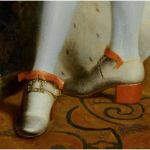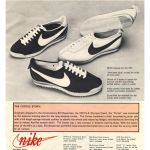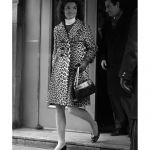
5 shoes that shaped the fashion history
From stilettos to Pilgrim pumps, from sneakers to boots
April 16th, 2021
From the gold-trimmed sandals worn by Cleopatra to the cuissardes boots by Courrèges, from the velvet and silk mules of the seventeenth century to the fake crocodile platforms of Vivienne Westwood in 1993, from the footwear with natural rubber soles worn by Henry VIII for relaxation at the waffle sole by Bowerman (Nike), shoes have a story that goes beyond the simple narration.
In fact, shoes can define a historical moment, as when in 1943 - during the Second World War - the Commission for American war production announced their rationing, prohibiting two-tone shoes, gold or silver, limiting the women's heel to a maximum height. of 14 centimeters and eliminating everything that was not necessary. Shoes also define the walk of the wearer, as in the case of Marilyn Monroe who, in order to sway in the gait and highlight her female body, is said to have made a shoe with a higher heel than the other - although this is probably just an anecdote.
And then there are also those who took off their shoes, like Isadora Duncan, who often performed in the gesture of throwing them away and remained to dance barefoot. Therefore, whether they are stilettos, sandals or Chelsea boots, shoes cannot be described as a simple accessory, but rather as a symbol, narrative feature and distinctive element of our personality. So here are some hints of history on 5 types of iconic shoes that have been able to make people talk about themselves and those who wore them.
Stiletto
White stockings and heel rouge, this is what Louis XIV wore, although there are those who say that the red men's heel was introduced by Filippo D’Orleans, his younger brother. Often shoes, and heels in particular, have been an element of social differentiation, just think of the high-soled sandals of ancient Greek women or the thin heels of New York women of the 1980s who could travel in limousines while most some of the other women had to wear sneakers to walk to work - and hide the heel in the bag. Yet, Roger Vivier had said that the stiletto heel was not designed for walking! Born after the Second World War, the stiletto embodied not only the vanity of women, but above all their femininity, sensuality and independence. In 1947 Dior, after causing a sensation with its New Look, added a higher and thinner heel to its skirts than those seen until then, but it was in 1953 - when it began to collaborate with Roger Vivier - that the heel (as we mean it today) was born. pin as we understand it today. Wearing it, women could emphasize their body and sway in the gait, feeling feminine and powerful, and perhaps, after having taken the place of men during the war as head of the family, the stiletto heel was just what they needed.
Boots
During the reign of Charles I the footwear - those for men - was influenced by military clothing, this because of the English Civil War (1642-49), and so the riding boots began to be worn in everyday life: it is even said that Charles I owned about twenty pairs. Until the end of the eighteenth century, women were used to wearing them only for horseback riding, but in the nineteenth century - when the skirts became shorter - they also began to wear them to protect themselves from the rain or for other activities such as cycling. In the twentieth century, however, boots became the symbol of female emancipation. In 1966 Nancy Sinatra sang These Boots in a pair of white boots and it was not only the world charts that went crazy, but also an entire generation of women who moved away from the post-war and 1950s mentality. From Mary Quant to Courrèges, the boots originally used for horseback riding underwent a total transformation and became shiny, colored, made of vinyl or pvc, wide, tight or thigh-high, but above all they became the symbol of cultural change.
Platform shoes
That of platform shoes is an all-Italian story, even if they had already been seen in the theater of ancient Greece, where the actors used them to play noble characters. It was Salvatore Ferragamo, in fact, who had the right intuition to fill all the space from the heel to the forefoot to create a new type of heel, and he did it using cork, as had already been done in ancient times: it was a real so successful that the new shoe model was patented all over the world. Then in the 1970s, after a brief disappearance from the fashion scene, the wedge heel made a name for itself, this time worn by both women and men - who hadn't worn heels since Versailles. They were made of wood, cork, raffia and rope, they could be colored, excessively tall or decorated with sequins and sequins. It was the time of the Saturday Night Fever and everyone wore tailored suits, London was the city of fashion and platforms were used both during day and night, representing the generation that would revolutionize the modern and contemporary world.
Pilgrim pump
Yves Saint Laurent, like Dior, also asked Roger Vivier for help to create the perfect footwear for his prêt-à-porter clothes. In 1962 Yves had launched his line with the Beat Look, bringing street style into a world of couturiers accustomed to working with tulle. Saint Laurent's work reflected the new generations, bored by the aristocratic taste, and made youth culture a protagonist in the fashion scene. Roger Vivier then created a low-heeled décolleté shoe with a square toe, with a silver buckle on the upper, which went down in history as the Pilgrim Pump. From Jackie Kennedy to Catherine Deneuve, there were many muses who wore it, making it famous and selling more than 200,000 pairs. For the first time the younger generations were considered as potential consumers and low heels became the symbol of a nascent and alternative culture.
Sneakers
It might seem almost absurd to think that at the time of Henry VIII shoes with natural rubber soles were used for moments of relaxation, yet it is so, the sneaker, which represents our contemporaneity par excellence, has its roots in distant times, although it was known and worn all over the world in the 1980s. Originally put on the market with the name of athletic shoe, it was immediately renamed sneakers for the ability to move silently - to sneak - that was acquired by wearing them. In 1917 Converse launched its All Star on the market, a few years later the German brothers Rudolf and Adolf Dassler created their footwear business for athletes, in 1942 - after a quarrel - they separated and founded adidas and Puma. Then in the 1970s, University of Oregon track and field coach Bill Bowerman and track and field champion Phil Knight began designing shoes and founded Nike. Sneakers immediately began to be worn by everyone as a leisure shoe and soon entered the daily dress code of most people. Today, designers from all over the world reinterpret the various types of footwear by changing their shape and reinterpreting them, yet sneakers, as also stated by the archives of the V&A museum, are the only shoes that, even if reinterpreted, have remained constant in the history of fashion.



































































